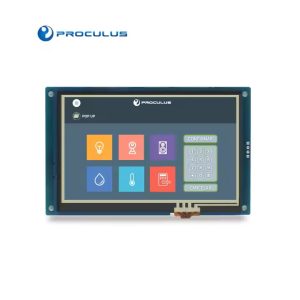Optical Film Design for Display LCD TFT Module
Display LCD TFT screens have optical films that include diffusion films, brightness enhancement films, and polarized brightness enhancement films. This article mainly introduces the structure design of optical films, focusing on the following aspects: gap between optical films and glue frames, position fixation, scratch resistance, and wrinkle prevention.
Gap between display LCD TFT modules and glue frames
The gap design between optical films and glue frames should consider the horizontal size and vertical thickness. The setting of the horizontal and vertical gaps should not only consider material tolerance but also the expansion of optical films affected by the environment. The thickness of optical films should also consider the effects of humidity and temperature on dimensional changes and the best combination of different films. When purchasing wholesale TFT LCD modules, it is essential to ensure that this gap is minimal or non-existent, as it can create issues such as dust accumulation, light leaks, and reduced clarity. Properly fitting and bonding the display module to the glue frame is crucial to achieving optimal performance and preventing potential product defects. Therefore, it is important to choose a reputable supplier that guarantees a tight fit between the LCD module and glue frame in their wholesale TFT LCD products.
Position fixation of display LCD TFT modules
To avoid looseness in the gap range, the position of optical films should be fixed. The common method is to use the dovetail joint method where the glue frames have a concave design and optical films have a convex design. To prevent optical films from being assembled upside-down or left-right reversed, asymmetric anti-mismatch arms are designed on one or three sides of optical films and are locked into place with the glue frames.
Scratch resistance of display LCD TFT modules
In vibration and shock tests, scratches on optical films caused by friction and foreign objects can lower the display quality of the entire TFT liquid crystal module. Therefore, these problems should be considered and avoided in the design phase. To prevent scratches caused by friction, the position fixation of optical films should be designed, and the optimal gap between optical films and glue frames should be established. Scratch-resistant optical films can also be selected and treated on their surfaces. Most LCD displays come with a protective layer that can help prevent scratches, but it is important to ensure that this layer is of high quality and durability. Scratch-resistant coatings can be applied to the surface of the display module to provide an extra layer of protection, which is particularly important for applications that require frequent use or exposure to harsh environments. Choosing a reputable supplier that offers high-quality wholesale TFT LCD display modules can help ensure that the product is scratch-resistant and meets the desired level of performance.
Wrinkle prevention of display LCD TFT modules
Wrinkles on optical films in high-temperature and high-humidity experiments can reduce the display quality of the entire TFT LCD screen module. Thicker optical films can alleviate the occurrence of wrinkles. Moreover, establishing the optimal gap between optical films and glue frames can also reduce the probability of wrinkles.
The brightness of TFT LCD screens is the product of the backlight brightness and the transparency of the display. Increasing the backlight brightness is a common method to improve the TFT LCD brightness, but it also increases the cost and brings many other quality and reliability issues due to the rise of the backlight source temperature. The fundamental way to improve brightness is to enhance the transparency of display LCD TFT. This can be achieved by improving pixel opening rate, liquid crystal transmittance, polarizing plate transmittance, and CF transmittance.

 English
English


